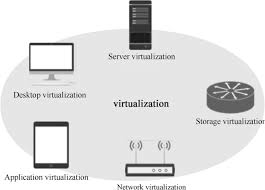
Maximizing Efficiency with Virtualization Technology: A Modern Computing Solution
The Impact of Virtualization Technology on Modern Computing
Virtualization technology has revolutionized the way computing resources are managed and utilized in today’s digital landscape. By abstracting physical hardware and creating virtual instances of servers, storage devices, and networks, virtualization has enabled organizations to maximize efficiency, flexibility, and cost-effectiveness.
One of the key benefits of virtualization technology is its ability to consolidate multiple physical servers into a single virtual server, known as server virtualization. This not only reduces the physical footprint of data centers but also optimizes resource utilization by allowing multiple operating systems to run on a single physical machine.
Moreover, virtualization technology has simplified disaster recovery processes by enabling quick backup and restoration of virtual machines. In the event of hardware failure or system crashes, organizations can swiftly recover their data and applications without significant downtime.
Another significant impact of virtualization technology is its role in cloud computing. Virtualized environments form the foundation of cloud infrastructure, allowing for scalable and on-demand access to computing resources. Cloud service providers leverage virtualization to deliver cost-effective solutions that cater to the dynamic needs of businesses.
Furthermore, virtualization technology has paved the way for software-defined networking (SDN) and network function virtualization (NFV). These technologies decouple network services from underlying hardware, enabling greater agility and scalability in network management.
In conclusion, virtualization technology continues to shape the modern computing landscape by enhancing resource utilization, streamlining operations, and facilitating innovation in IT infrastructure. As organizations increasingly embrace digital transformation, the role of virtualization in driving efficiency and flexibility will only become more pronounced.
6 Key Benefits of Virtualization Technology: From Cost Savings to Enhanced Disaster Recovery
- 1. Improved resource utilization
- 2. Cost savings
- 3. Enhanced disaster recovery
- 4. Scalability
- 5. Simplified management
- 6. Energy efficiency
Challenges of Virtualization: Navigating Complexity, Performance Overhead, and Security Risks
1. Improved resource utilization
Virtualization technology offers a significant advantage in improved resource utilization by enabling more efficient allocation and usage of computing resources. By creating virtual instances of servers, storage devices, and networks, organizations can optimize the distribution of resources based on demand. This results in increased efficiency as virtualization allows for the dynamic allocation of resources to meet varying workloads, ultimately maximizing the utilization of available hardware. The ability to scale resources up or down as needed ensures that computing resources are utilized effectively, leading to cost savings and enhanced performance across IT infrastructure.
2. Cost savings
One of the key advantages of virtualization technology is the significant cost savings it offers to organizations. By consolidating multiple servers into virtual instances, businesses can streamline their hardware infrastructure, leading to reduced hardware and maintenance costs. This consolidation not only minimizes the physical footprint of data centers but also optimizes resource utilization, resulting in lower operational expenses. Additionally, by leveraging virtualization technology, organizations can achieve economies of scale and better allocate their IT budgets towards strategic initiatives rather than routine maintenance tasks.
3. Enhanced disaster recovery
Virtualization technology offers enhanced disaster recovery capabilities by streamlining backup and restoration procedures. By creating virtual instances of servers and data storage, organizations can quickly recover from system failures or hardware malfunctions. This efficiency in disaster recovery is crucial for minimizing downtime and ensuring business continuity in the face of unexpected disruptions. Virtualization’s ability to simplify and expedite backup and restoration processes significantly enhances the resilience of IT infrastructure, providing peace of mind to businesses relying on uninterrupted operations.
4. Scalability
Virtualization technology offers a crucial advantage in terms of scalability. By creating virtual instances of computing resources, businesses can easily adjust their capacity to meet changing demands without the need for extensive infrastructure modifications. This flexibility allows organizations to efficiently scale up or down based on workload fluctuations, ensuring optimal resource utilization and cost-effectiveness. The ability to quickly and seamlessly expand or contract virtualized environments makes scalability a key benefit of virtualization technology for modern businesses striving to stay agile and responsive in dynamic market conditions.
5. Simplified management
Virtualization technology offers the significant advantage of simplified management through centralized tools that streamline the monitoring and control of virtualized resources across the network. By providing a centralized interface for administrators to oversee and manage virtual machines, servers, and storage, organizations can efficiently allocate resources, troubleshoot issues, and ensure optimal performance with ease. This centralized approach not only enhances operational efficiency but also enables quick decision-making and proactive management of IT infrastructure, ultimately contributing to a more agile and responsive computing environment.
6. Energy efficiency
Virtualization technology offers a significant advantage in energy efficiency by enabling the consolidation of multiple virtual machines on a single physical server. This consolidation results in reduced energy consumption, ultimately leading to lower operational costs for organizations. By optimizing resource utilization and minimizing idle hardware, virtualization not only contributes to cost savings but also aligns with sustainable practices by reducing the overall carbon footprint associated with running data centers.
Complexity
Implementing and managing virtualized environments can present a significant challenge due to the complexity involved. Organizations may encounter difficulties in setting up and maintaining virtualized systems, as it requires specialized skills and knowledge that not all IT professionals possess. From configuring virtual machines to troubleshooting compatibility issues, the intricacies of virtualization technology demand a high level of expertise. The complexity of managing virtualized environments can lead to delays in deployment, increased operational costs, and potential risks if not handled effectively. As such, organizations must invest in training their staff or seek external expertise to navigate the complexities associated with virtualization technology.
Performance Overhead
One significant drawback of virtualization technology is the performance overhead it can introduce. This occurs because virtualization adds an extra layer of abstraction between the hardware and software, which can lead to a decrease in system performance. The overhead may manifest as slower processing speeds, increased latency, or reduced throughput, impacting the overall efficiency of computing operations. Organizations must carefully consider and mitigate this performance impact when implementing virtualization solutions to ensure optimal system performance and user experience.
Security Risks
Security Risks: Virtualization technology may introduce new security vulnerabilities if not properly configured and secured. One of the key concerns with virtualization is the potential for unauthorized access to virtual machines or hypervisors, leading to data breaches and system compromises. Without robust security measures in place, malicious actors could exploit weaknesses in virtualized environments to gain access to sensitive information or disrupt critical services. It is essential for organizations to prioritize security protocols, such as network segmentation, encryption, and regular vulnerability assessments, to mitigate the risks associated with virtualization technology and safeguard their digital assets effectively.

